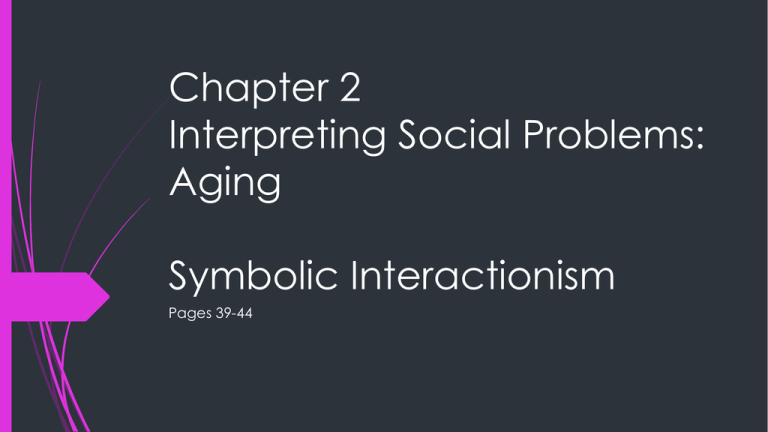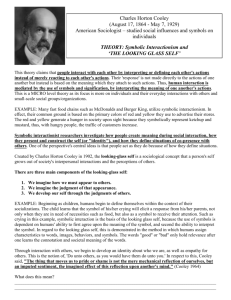
Chapter 2
Interpreting Social Problems:
Aging
Symbolic Interactionism
Pages 39-44
Symbolic Interactionism
The sociological theory that focuses
on how we make sense out of life is
called symbolic interactionism.
We see the world through
symbols, things to which we
attach meaning and that we use
to communicate with one
another
SI studies how symbols give us our
view of the world and how we
use them to communicate
Our views of life include what we
consider to be social problems
What are symbols?
What are symbols?
What are symbols?
What are symbols?
Symbols:
Images on television
Movies
Printed and spoken
word
Body language
Gestures
Tone of voice
Clothing
Hair styles
Symbols Today
In 1970 Robin Williams identified core
American values:
• Equal Opportunity
• Achievement and Success
• Material Comfort
• Activity and Work
• Practicality and Efficiency
• Progress
• Science
• Democracy and Enterprise
• Freedom
From Macionis, John J. 2005. Sociology. 10th ed. Upper Saddle
River, New Jersey: Pearson Prentice Hall. p. 66.
• How is your celebrity different or similar to J.Lo?
• What does this image of a celebrity tell us about how
we should live our lives, how we should look and
behave?
• Do you think you should strive to be like celebrities?
(both in terms of looks and lifestyle)? Why or why
not?
Symbols Change
“Old” used to mean wisdom,
generosity, graciousness, and
beauty
The elderly were admired for
their accomplishments and
accumulated knowledge.
As society advanced in
public heath and medicine,
many people reached old
age and the elderly were no
longer distinct
Symbols Change
With machinery and mass
production, work was becoming
“deskilled”
Younger workers became just
as knowledgeable and
productive as the older ones
As the elderly lost the uniqueness
that had brought them respect,
their social value declined
“old” begins to mean
uselessness, foolishness, and no
longer looked up to
Symbols Change
Because symbols change, so do
social problems
When only a few people made
it to old age, it was a personal
problem, not a social problem
Today, with so many people
reaching old age, we perceive
elderly people as a group
Social action is appropriate
for solving their problems
Development of Symbolic Interactionism
How we symbolize our self and others influences our
behavior.
All of us make choices on the basis of what we
think fits our self-images
George Herbert Mead focused on the role of
symbols in social life
Symbols allow us to have goals, to plan, to
evaluate, and to develop our self-concept
Symbols allow us to take the roles of others and
put ourselves in their shoes
Mead called this action of taking the role of
other people in general the generalized other
Development of Symbolic Interactionism
Charles Horton Cooley
analyzed how the self develops
through interactions with others
people come to view
themselves as they think
others perceive them
Our interactions with others
create a looking-glass self
Development of Symbolic Interactionism
Our self has 3 elements:
How we imagine we appear to
others
How we think others feel about
what they perceive
How we feel about this reflected
image
Our self-esteem depends on our
looking-glass self
If a society reflects negative
images to its old people, the
elderly tend to think of themselves
negatively
Development of Symbolic Interactionism
Peter Berger and Thomas Luckmann
developed the concept of the social
construction of reality
When things happen to us we have
to figure out what they mean
Based on what we think they mean,
we respond with a reaction
As we go through life we
continuously make sense out of what
happens to us
Another way of saying this is that each
of us is involved in the social
construction of reality.
Development of Symbolic Interactionism
Reality does not come with
built-in meanings, but, we
construct our realities as we
apply symbol to our
experiences
Ex: When is someone
considered old? Why?
Because not all cultures
have the same symbols, the
construction of reality
changes from culture to
culture
A suicide in America does not
have the same symbols that
explain the action. Symbols are
that it is the family’s responsibility
to prevent the suicide which leads
to guilt.
Classwork/Homework
Read page 45
Write a one page response
Applying Symbolic Interactionism to Social
Problems
Social problems are socially
constructed.
social problems do not exist until
some condition of society is called
a social problem
The fact that there are elderly people
does not mean that there is a social
problem
the status of the elderly depends on
how the elderly are viewed or
labeled
Because social problems are socially
constructed, what is considered a
social problem changes over time
Applying Symbolic Interactionism to Social
Problems
Symbolic interactionists stress
the significance of labeling
people categorize
everything
Ex: the label of “old age” is
sometimes used to explain
health problems
Labels affect how we
perceive and react to social
problems





